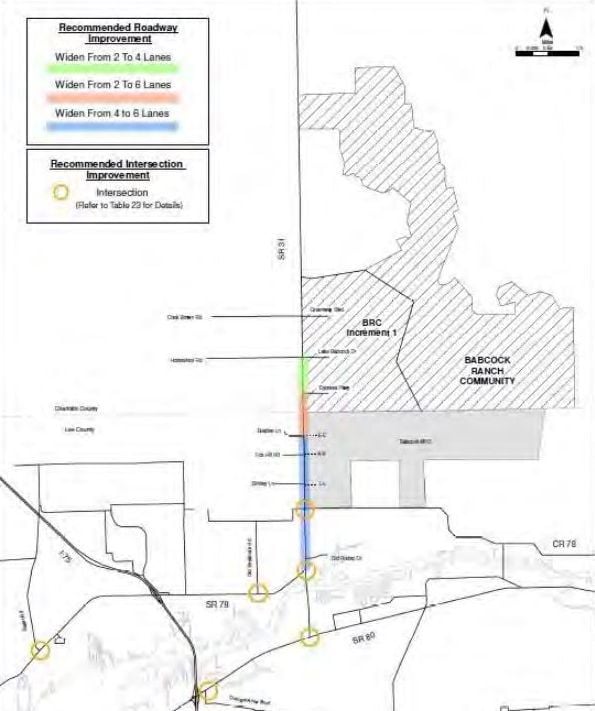NEWS
NEWS
April 23, 2020
Babcock Ranch needs to build a lot more in central neighborhoods
By: Vicki Parsons - IT
By BETSY CALVERT Staff Writer
April 13, 2020

This map shows areas where developers of Babcock Ranch will be working with the state to widen State Road 31 and improve intersections in Charlotte and Lee counties.
Babcock Ranch wants to dramatically increase the amount of homes and commercial space in its first phase of development.
The Charlotte County Planning and Zoning Advisory Board on Monday voted unanimously to recommend the changes when it goes before the county commission.
The overall entitlement of 17,500 homes in this county does not increase with this application, County Planner Jie Shao told the Sun^p before the meeting. Babcock also is entitled for another 2,000 homes in Lee County, but has not started construction there.
For phase 1, which is 5,095 acres, Babcock originally planned years ago to build 2,000 homes with 50,000 square feet of retail and 140,000 square feet of office space on farmland and gravel mines. If commissioners approve the increase, they would be allowed up to 5,000 homes and 870,000 square feet of retail, 350,000 square feet of office space. It would also add a hotel with up to 600 rooms and an 18-hole golf course.
Currently, there are about 1,158 residents, said spokesperson Lisa Hall, with 630 homes sold since the project opened in 2017.
The lawyer for Babcock Partner Holdings LLC, Rob Berntsson, said part of the need for the increase is to help the project fulfill its commitment to pay for more of the work to widen state roads. The developer was only required to commit $45 million to the widening of State Road 31 in Lee and Charlotte counties. Now, Berntsson said, they have upped that to $85 million. Improvements include expanding the road in several areas and improving intersections to accommodate thousands of new residents, shoppers and workers in the near future.
“They’re committing to a lot more than they’re required to,” Berntsson told the Sun^p.
Board member Steve Vieira noted he had to read through 1,500 pages to familiarize himself with the proposal. He asked if this deal means that Babcock will not grow beyond this phase 1. The answer was no, the project can go much farther in the future.
Babcock could grow to 50,000 people on the full 19,000 acres, of which only 9,000 are available for development. The rest are set aside as open space.
The deadline for buildout of phase 1 is extended to 2026 for infrastructure and 2033 for all building. Phase one includes the central village area and all the seven subdivisions currently underway, plus land to the north where acres of solar panels sit.
Board Chairman Michael Graveson asked in the increase in development for phase one requires a transfer of density units, where the developer buys land or development rights on land that could be developed, and agrees not to develop there. The answer to that was also no, due to the overall 17,500 maximum allowed residences.
“This is one of those things that never stops changing,” Berntsson said of the development agreement of this scope.
Babcock has been on the design board for at least 15 years with founder Syd Kitson negotiating with the Babcock heirs, state officials, investors and environmental conservationists to arrange a deal. Before 2010, Babcock developers began negotiations with Charlotte County for a Development of Regional Impact. That complex document outlines what the developer will build, where and when to control impact on schools, traffic and the environment. The agreement has been revised several times.
Copyright © 2003 - 2024 Kitson & Partners. All Rights Reserved.



